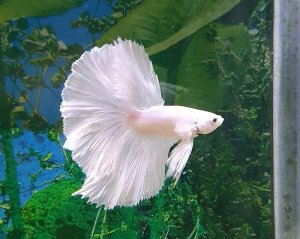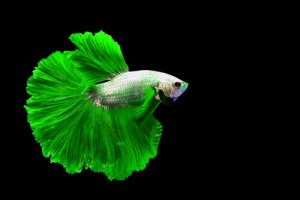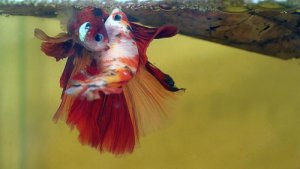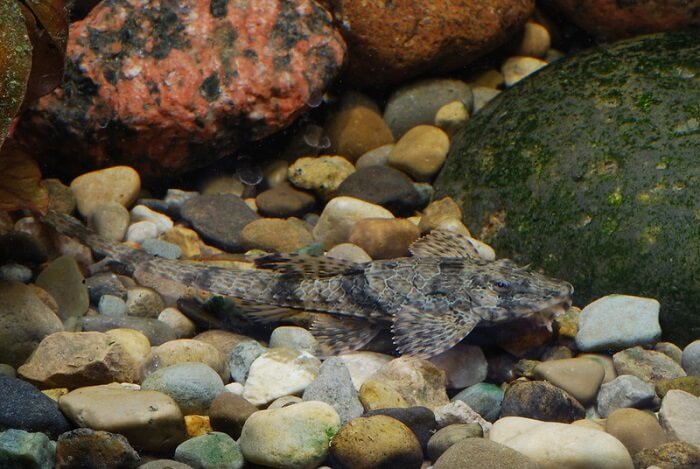
One of the more underrated Catfish species among aquarium enthusiasts and hobbyists is the quite bizarre-looking Whiptail Catfish, It falls under the social category of Oddball fish that do not fall under the main categories of aquarium fish that are regularly seen.
With so many genera and species available in the Whiptail Catfish, we will be focusing more on the even more odd looking, and smaller Rineloricaria species that is the ideal addition to any communal tank, with its hardy adaptability, and peaceful nature.
Breed Overview
| Origin | South America |
| Lifespan | 5-8 years |
| Size | 6 cm (3 inches) up to one foot in length |
| Colors | Brown, yellow, red, gray, tan |
| Food | Carnivorous and omnivorous depending on the species |
| Tank Size | A minimum of 30 gallons for smaller species |
| Temperament | Peaceful and timid |
| Water Temperature | 72-82°F (22-28°C) |
| Water pH | 0 – 8.0 soft and slightly acidic |
| Difficulty Level | Easy for Beginners, depending on the species |
Species Roster And Natural History
Rather than doing a specific species overview, here are some other Whiptail Catfish species, and touch on the history behind these incredible creatures.
Natural History And Origin Of Whiptail Catfish
According to ichthyologists (marine biologists studying different fish species) have essentially divided the Whiptail Catfish into two basic tribes, as they are known, the Loricariini and Harttinni.
- Loricarriini – They are the hardiest and most adaptable, though they are carnivores rather than algae. The Tribe prefers to live in rivers, preferring sandy substrates and leaf litter, and they are mostly native to the Amazon and Orinoco in South America.
- Harttiini – The Harttiini tribe broadly speaking are more challenging to keep and do not adapt well to aquarium living. They are algae-eating, and will similarly consume microorganisms that live in algae, thus omnivores. The tribe prefers solid wood or rock substrates and enjoys fast-flowing rapids and streams with fresh water.
Species Roster And Description
As mentioned in the beginning the Whiptail Catfish is an extremely diverse species, with over 30 genera (taxonomic categories into which the species are divided), Unfortunately, some have never been in the aquarium trade. So to give you a clearer understanding, the species will be divided under their Hartiini and Loricarriini tribes.
- Loricarriini
In this tribe the Rineloricaria (Hemiloricaria) contains the smallest species and is the most popular in aquarium shops, hence why we will be focusing on this species mostly. Favorites among the Rineloricaria are the common Whiptail Catfish, (R. Parva) and the Red Dragon Whiptail Catfish (R.sp.).
Now and again the Loricaria, such as the Marbled Whiptail Catfish, Planiloricaria, Flounder or Spoon Faced Whiptail, and Pseudohemiodon, Giant Whiptail Catfish species may be found, only to name a few.
- Hartiini
From this tribe, we have a few species, though they are much harder to keep and have much more specific requirements. Starting with the Farlowella genus has around 30 species, the most common being F. Acus, or the Twig Catfish, F. Gracilis, Kleiner Nadelwels, and the F. Vittate, also known as Twig Catfish.
Then you get the Sturisoma which are larger in size and quite a prized catfish species. There is the Sturisoma Aureum, the Giant or Golden Whiptail, and Sturisoma Barbatum, or Longnose Whiptail Catfish that are more popular, as well as the Sturisoma Panamese, or Royal Whiptail Catfish.
The Lamontichthys Filamentosus, or Sturgeon Catfish is a smaller medium-sized catfish with a unique single pectoral fin spine and seven pectoral fin rays on each fin.
One particular Whiptail Catfish interesting to further elaborate on is the Royal Whiptail Catfish:
- Royal Whiptail Catfish (Farlowella Acus)
As part of the larger (Farlowella Acus) species of Catfish from the Hartiini tribe, the Royal Whiptail Catfish is also known as a Twig catfish species with a pointed needle-like shape reaching around 16cm (6.3) inches in size, with color ranges of olive green, to yellow-brown, and nested blotches from the head to the tail.
The male has distinctive bristles on its snout when mature and the female has a smooth snout.
Rineloricaria Color Variations
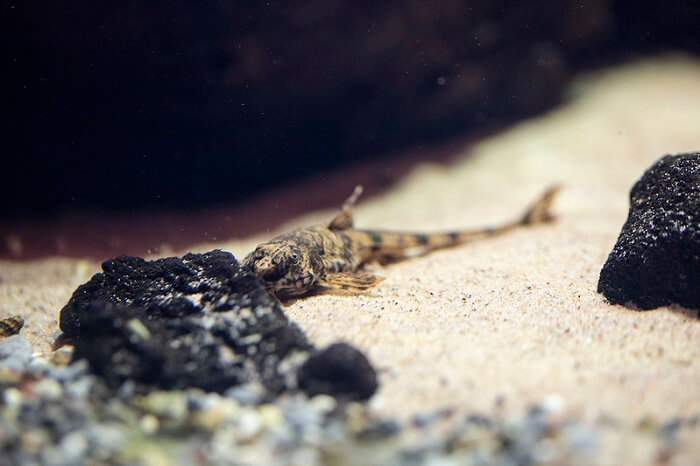
The Rineloricaria species is well-known for its long nose, and the long filament growing from the tip of the caudal fin, characteristic of this genus.
Male And Female Differences
On the subject of male and female differences, much will depend on the specific Rineloricaria species, though commonly males develop odontodes (small thorn structures on the skin) on their heads and pectoral spines, which females do not. You will notice mostly that females are much older and harder than males in general.
Other Variations
There are mainly 64 recognized species of Whiptail Catfish in the Rineloricaria genera, thus we will not be going into each individually, however, there is one specific, and very popular color variation worthy of mentioning;
Red Lizard Whiptail Catfish – Known as the Rineloricaria sp. (L010a) of the Loricariidae family. The Red Lizard Whiptail has a very thin twig-like body and is a suckermouth species native to South America, bred on a large scale in the pet trade.
Lifespan And Size Of Whiptail Catfish
Whiptail Catfish species, in general, are a smaller size from the Loricarriidae tribe, and larger sizes, up to giant sizes in the Hartiini tribe. However, for the Rineloricaria species, the average size of an adult Whiptail is around 13 cm (5 inches). The lifespan ranges between around 5 – and 8 years with proper care for the species.
Temperament And Behaviour
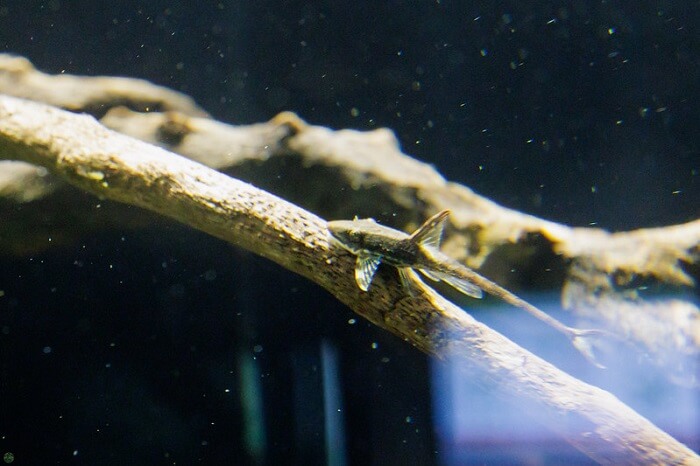
Whiptail catfish species overall have brilliant temperaments. They are peaceful, easily cohabitate with other fish, and are quite interesting to watch as they walk on their fins rather than swim mostly.
It is advised to be careful with more territorial fish around them that may fight for grazing space. Whiptails may be kept in groups or pairs of males and females, just be careful with males being slightly territorial.
General Care
Caring for any Whiptail Catfish species from the Loricariidae tribe is relatively easy, especially the Rineloricaria which we will be focusing on. Keep in mind they tend to forage in open water conditions, thus it is advised to closely mimic their natural habitat.
Mostly they are carnivores, and not essentially algae eaters, foraging on small insects and larvae. You may want to add them to your settled community tank or create a new aquarium for them, so let us look further into their aquarium requirements.
Aquarium Set-Up
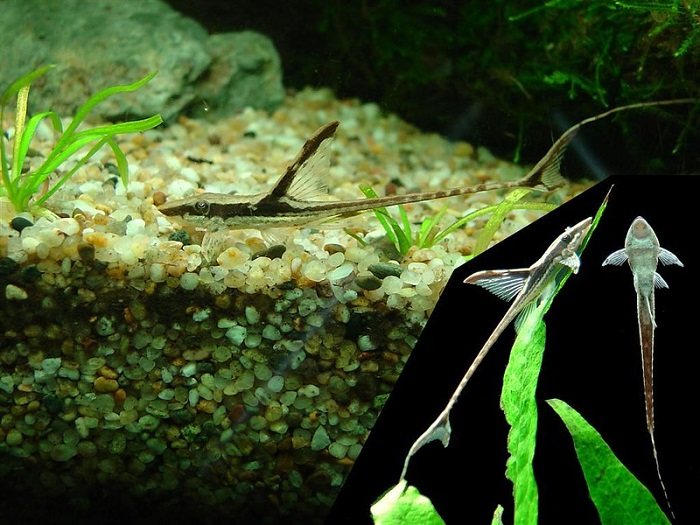
Whiptail catfish are generally adaptable and hardy, flourishing in clear and whitewater (water with sediment) conditions. They prefer anything from streams, lagoons, and other shallow water bodies in their natural environment, and they are open-ground foragers rather than hiding out.
You can keep them in small groups or a pair, with a male and a female, they are suitable and happy on their own as well.
- Tank Size – The smaller species will do well in a tank of between 30 – and 50 gallons.
- Water Conditions – Whiptails are adaptable to soft and moderately hard water conditions, but enjoy slightly acidic water with a pH of around 6.0 to 8.0. Water temperatures should be kept warmer in the ranges of 72-82°F (22-28°C), as they are used to more tropical climates, though they can tolerate colder water conditions.
- Filtration – Most Whiptail species need highly oxygenated water conditions, and hefty currents, thus you may need a specialized filter and pump to recreate the waves of their natural habitat. Luckily you can easily enquire with your local aquatic pet store for a filter that will create strong currents.
- Light -They do need a well-lit environment, mostly LED light is recommended and a clear indication of day and night, when lights can be dimmed.
- Heat -To reach proper water temperatures you will need a good heater and thermometer to keep temperatures in check. The size and type of heater will depend largely on the size of the tank that you choose.
Decorating Your Tank
Creating a living space for Whiptail catfish is quite simple, and it is highly advised to try and keep it as natural as possible.
- Substrate -Soft sandy substrate with leaf litter such as Indian Almond Terminalia Catappa leaves, or even low-lying plants will be ideal for Whiptails, to create more open spaces.
- Ornaments And Toys –You can include some driftwood and rocks on the edges of the tank, but keep an open space for them to forage.
- Live Plants -Low-lying plants are ideal for Whiptail Catfish providing oxygen, foraging space, and even safe hiding spots. Plants such as Cryptocoryne, Anubias, Java Moss, Dwarf Hairgrass, and Dwarf Lilies are ideal, as well as large-leaved plants such as Amazon Swords.
Introducing Your Whiptail Catfish To Its New Home
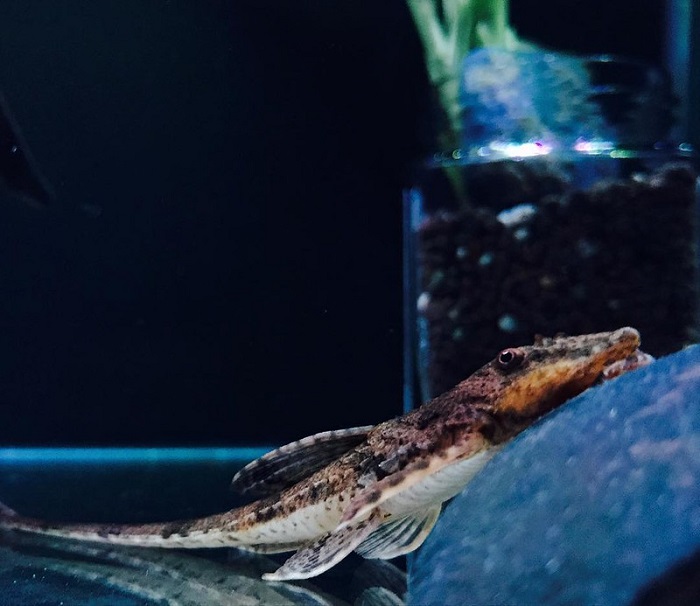
Whiptail catfish are quite hardy and adaptable, and could easily be introduced to a suitable communal tank with similar water parameters and the right décor. However, for an initial tank, it is important to do a proper cycle to obtain the right water parameters first.
Choosing A Healthy Fish
When purchasing a Whiptail Catfish you can keep them in groups if your tank is large enough, a male or female pair, in which case you will need to select adults, or as a single fish.
Take care to find a reputable breeder or trusted pet store and look for these signs of health:
- Whiptails will have a healthy and eager appetite.
- The body must be well-rounded and shaped with no bloating or hollow areas in the abdomen.
- Eyes must be clear and normal and not cloudy, or bulging out.
- The tail and fins must be clear with no damage or discoloration.
- The fish needs to have a clear and even coloration with no blotches or white spots.
Adding Your Fish To The Tank
As with any other fish species it is advised to acclimate your Whiptail by allowing it to float on the surface of the water first for around 30 minutes. Then you can replace the water in the bag with that of the tank at intervals, small amounts for another 30 minutes, after which your Whiptail should be adapted.
Suitable Tank Mates For Whiptail Catfish
Whiptail Catfish species, especially the smaller Loricariidae species are extremely peaceful fish that easily share a communal tank with other fish, even with their species, given enough space is available to avoid territory arguments.
They are essentially mildly territorial, and very timid, slow-moving fish that would rather try to look inconspicuous and stay still, rather than fight, or show aggression.
However, this makes them very susceptible to attacks from other aggressive, or fin-nipping fish species, as they will not try to escape or defend themselves. Thus, similar peaceful-natured tank makes are to be considered.
Mostly docile mid-water schooling fish such as smaller Tetras, Rasboras, Danios, Corydoras, and Kuhli Loaches are ideal. Gouramis and peaceful Dwarf Cichlids that show no aggression may similarly be suitable, though not recommended. Specifically, Tiger Barbs, Serpae Tetras, and Pufferfish need to be avoided, along with other aggressive fish species.
Feeding Your Whiptail Catfish
Whiptail catfish species from the Rineloricaria genera are generally not demanding eaters and care should be taken that there is enough food for them to forage on after tank mates have had their share.
What To Feed
Mostly catfish pellets and algae wafers are ideal as a staple food, and because they are more carnivorous, you can supplement their diet with blood worms, insect larvae, and chopped-up seafood.
How To Feed
Whiptail catfish are open-water feeders and will forage on the surface. They need to be given some time to get enough to eat, though there should not be too much leftover food that could cause ammonia spikes in the water.
Tank Maintenance
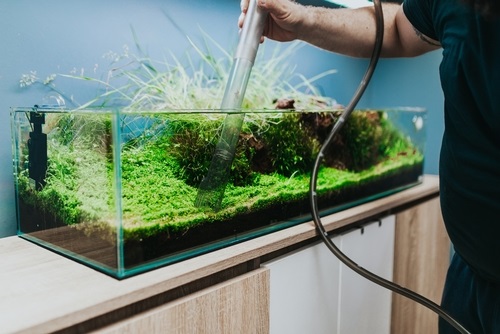
As Whiptails prefer highly oxygenated and clean water, regular tank maintenance is a requirement. Weekly water changes can be done by siphoning the water with a hose from the bottom of the tank, removing 30% of the water, and replacing it with fresh water that has been conditioned and heated to the correct parameters.
As Whiptail Catfish are not avid algae eaters you may need to clear excessive algae from your tank or decorations from time to time.
Common Pests And Diseases In Catfishes
Whiptail Catfish are exceptionally hardy, especially those from the Loricarriini family, though they are susceptible to the most common freshwater fish parasites and health conditions.
- Ich – Ich is a very common parasite that attacks freshwater fish, and it is quite infectious. If your Whiptail shows signs of white spots on its body and skin and starts to lose its appetite, it may have this protozoan parasite. Ich must be treated by quarantining your fish in clean water conditions, and you can use medication for the parasite. Quarantine needs to last at least a week for the parasite to end its life cycle. Ich is usually introduced with new plants or tank mates that already have the parasite.
- Bacterial And Fungal Infections – There are quite a few bacterial and fungal infections that could affect your Whiptail. Fin rot where an injured fin and poor water conditions can lead to a bacterial infection is the most common. Issues with the swim bladder will similarly mostly be caused by a fungal or bacterial infection. Bacterial and fungal infections can be treated by quarantining your fish and using a prescription or over-the-counter medication and antibiotics.
- Worms – Catfish are also susceptible to worms that may attach to the gills or form in the intestines. Worms can be treated with an over-the-counter dewormer.
- Indigestion – Many times basic indigestion in catfish has been diagnosed as dropsy or a swim bladder infection when your fish has eaten either too much or foods that have caused indigestion. Driftwood is often used to aid in digestion with catfish species, and a proper diet should keep your fish healthy. You can similarly introduce a few shelled peas to help with indigestion.
How To Breed Whiptail Catfish
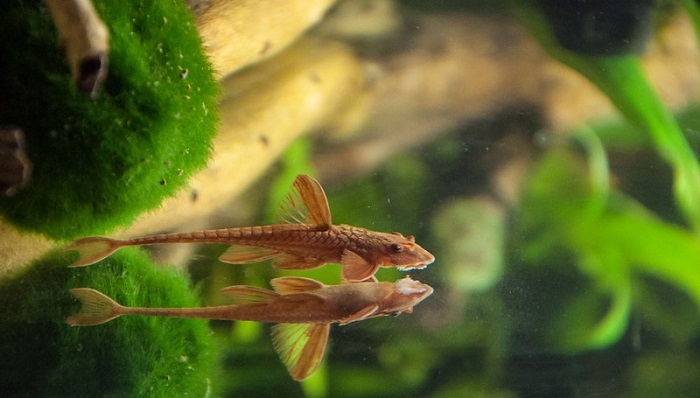
Depending on the specific species Whiptail Catfish will vary in their breeding compatibility. Luckily our main species Rineloricaria are easy to breed in captivity and have similar requirements and breeding habits to Bristlenose Catfish.
The smaller Rineloricaria catfish will breed without intervention if the tank conditions are suitable.
- Spawning – They will spawn in a hollow tube where the male will guard the eggs and chase the female away. The female typically lays around 100 eggs.
- Eggs And Fry – The eggs will hatch within a week, and the fry will maintain their yolk sac as a source of food until they become independent. You can feed them algae, infusoria, and flaked foods.
Easy enough though, not all Loricarriini Whiptail species have similar breeding methods. An interesting fact is that some larger open-water species will carry their spawn on their lips, called lip-brooding, because insufficient spawning habitats are available in their natural habitat.
In Conclusion
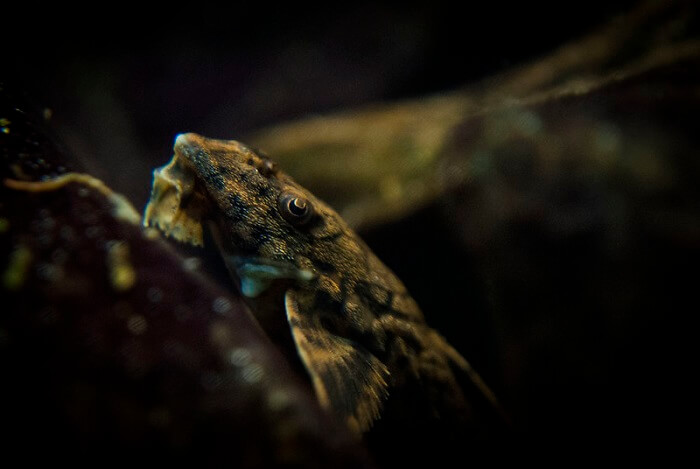
There is so much to say about the unique and completely curious-looking Whiptail Catfish, With so many different genera and species to this fascinating Catfish it is hard to combine all of them in one article. Though they all have similar peaceful natures and timid behavior.
The Rineloricaria, a smaller species that holds the gorgeous Red Lizard Whiptail color variation is what most research has been based on, essentially because they are a more well-known species in the pet trade and the easiest to breed.


